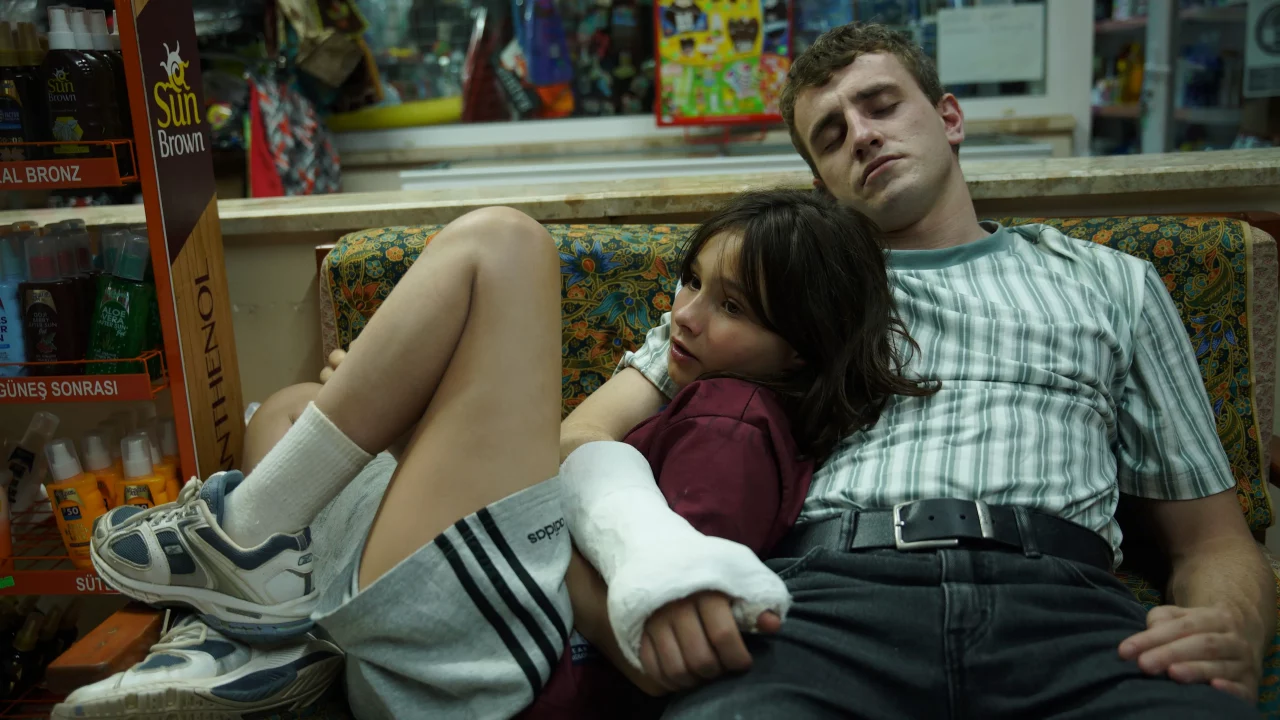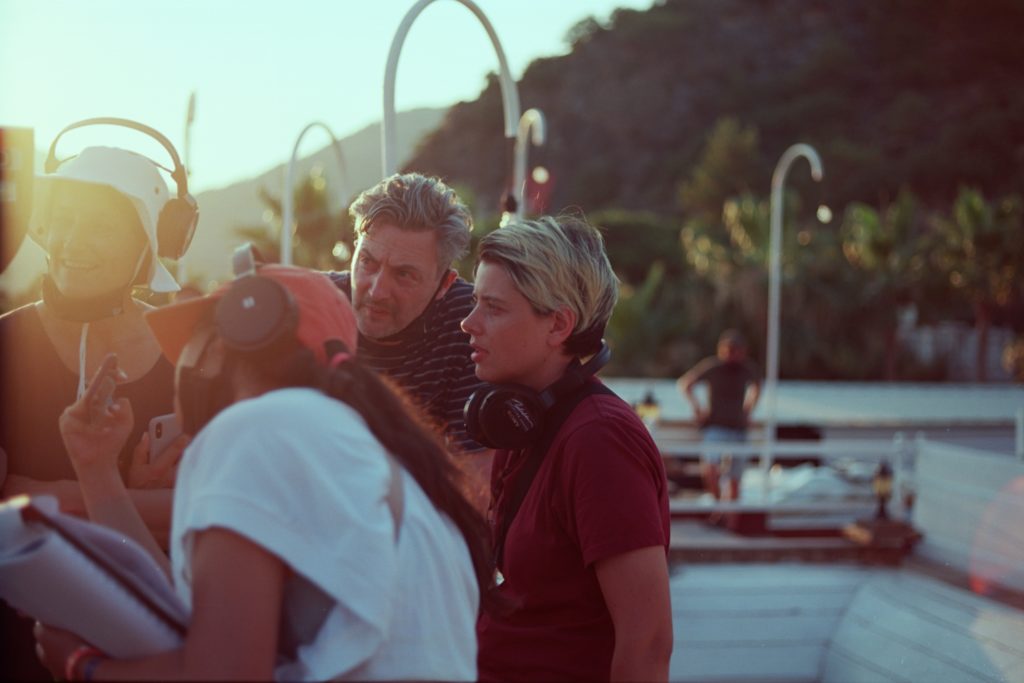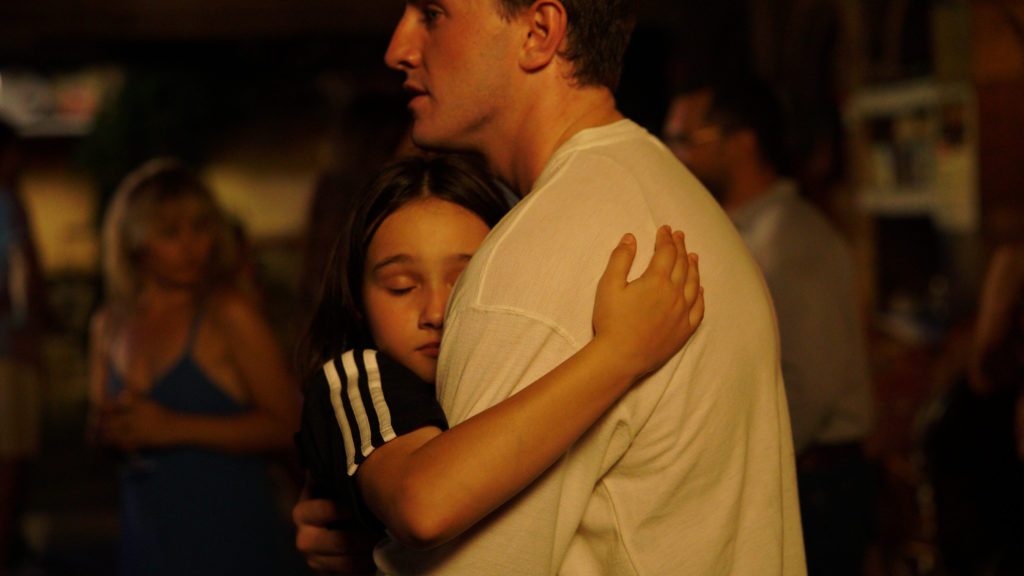Fathers, Daughters and Videotape
Charlotte Wells's "Aftersun" is the most precise and devastating piece of cinema this year. Frankie Corio and Paul Mescal. Photo: Courtesy of A24.
Frankie Corio and Paul Mescal. Photo: Courtesy of A24.
Aftersun
Dir. by Charlotte Wells
Nostalgia is easily evoked. A familiar catchphrase. A vintage article of clothing, snapped with the right Instagram filter. A beloved franchise from a bygone era. The more the film industry relies on the commodified nostalgia of reboots and pastiche, the less memory, with all its cinematic possibilities, seems to matter. This is why a film like “Aftersun” hits like a lightning strike to the senses. On its surface, the debut by writer-director Charlotte Wells tells a simple story: a young Scottish father and his tween daughter take a trip to Turkey in the late ’90s, documenting some of it on their camcorder; 20 years later, the daughter revisits the footage. But “Aftersun” is anything but simple. Its moving tapestry of abstractions is the most precise and devastating piece of cinema this year.
We first meet 30-year-old Calum (Paul Mescal) and 11-year-old Sophie (Frankie Corio) through rough camcorder footage shot on MiniDV tape. It looks positively ancient in the age of high definition, but at the time was a novel and easy way for families to preserve childhood memories. This living document features Frankie, camera in hand, teasing her father in their Turkish hotel room. Through rewinding and pixelation, we see that this footage is being watched back on a screen, by an adult woman sitting mournfully still, her reflection half-visible over Calum’s image. The footage is upbeat; the scene’s framing anything but.

These found footage segments are few and far between. “Aftersun” is set largely within the past — rather than at a distance from it — employing 35mm film cameras, and ostensibly “traditional” blocking and framing.
But Wells isn’t interested in the ebb and flow of traditional drama, of conflict introduced and resolved within a given span of time.
The plot follows the arc of a traditional holiday. Since Sophie lives with her mother, she and Calum get some much-needed time to catch up at a mid-budget poolside hotel. There’s relaxation, food, drinks and evening entertainment; Sophie makes a few friends, some her own age, some slightly older. It’s never uninteresting, given the actors’ lively dynamic and Sophie’s curiosities, but the nature of what we’re watching only sets in around an hour into the film’s 100-minute run time, when minor tensions begin to cascade and, eventually, overwhelm the father-daughter relationship.
How much we care for these characters hits slowly, and then, all at once, as Wells begins to train her camera on Calum’s suppressed personal demons. Given the movie’s flashback framing — it’s told from a nebulous “future” vantage that’s only clarified much later — it becomes apparent that “Aftersun” isn’t so much an act of recollection as an act of recontextualization and rigorous inquiry, one focused on the ways parents keep parts of themselves hidden from their children. When the reasons these tapes are being revisited finally snaps into place, the apparent vagaries of Wells’ script become laser-precise. It revisits the past, not only in search of signs missed, but with a richer, more mature understanding of their complexities.
Wells grounds us in the reality of this father-daughter trip through vivid, era-specific details, from articles of clothing to pop music tracks playing on poolside speakers.
When we’re young, our parents don’t seem to have the dimensions, the humanity, and the vulnerability we come to expect (and eventually, accept) as adults. Perhaps they hide it less. Or perhaps we learn to recognize the parts of them we now see in ourselves. We meet the young Sophie at just such a precipice of understanding, though she hasn’t quite learned to see the signs.
But rather than illuminating her perspective through dialogue or outward action, Wells paints a textured series of portraits, through tiny moments. Her first kiss. Her first real disappointment with her father. How she sees her own body and the bodies of her peers.
Wells grounds us in the reality of this father-daughter trip through vivid, era-specific details, from articles of clothing to pop music tracks playing on poolside speakers. However, she also occasionally yanks us out of time, through brief but imaginative vignettes of an adult Sophie (Celia Rowlson-Hall) under the strobing lights of a nightclub, an image whose pulsating presentation is both sexually and emotionally charged. It’s a filter of sorts, enhancing our understanding of the Turkey scenes in flashback. Wells offers glimpses into Sophie’s future, but connects it inextricably to a pivotal moment in the past when her relationship with her father is at a crucial crossroads.

“Aftersun” is the kind of film that demands to be rewatched. The first viewing is designed to result in seeing through Sophie’s perspective—the younger Sophie, that is. Possibilities, both exciting and infinite, lurk around every corner, as a pleasant holiday unfolds. On the second viewing, however, the same events are more likely to be seen through adult eyes. With a more complete picture of both characters in mind, you have a better sense of how to read them, from Paul’s behavior during seemingly minor interactions, to the nature of Sophie’s fleeting glances at those around her. On a physical level, nothing changes upon rewatch; no hidden logistical details emerge. On an emotional level, “Aftersun” rewards second viewings with a crystalline clarity.
“Aftersun” is the kind of film that demands to be rewatched.
This clarity is sharpened by the artistry at play, from Gregory Oke’s warm, grainy cinematography— enticing and mysterious in equal measure—to the nuanced work of its leading actors. Mescal unearths layer after layer to Calum with each passing scene (sometimes using body language alone, with his back to the camera), essentially performing the film’s artistic treatise on the ways people can be unknowable, and may reveal themselves in retrospect. Young newcomer Corio similarly personifies the narrative’s perspective, as a young girl caught between childhood innocence and an abrupt, adolescent terseness bubbling just beneath the surface.
Wells’ use of visual texture—the pixelation of old tape that instantly dates it, the timeless grain of film stock that makes the canvas feel alive — doesn’t just help capture her story. It resonates through that story in all directions, echoing through the medium itself, as if to turn the camera back on the nature of images, and the way we perceive them. It’s the kind of approach that turns a seemingly inconsequential moment —Calum and Sophie discussing nothing in particular, over a meal they’re unlikely to remember—into something powerful and bittersweet. A man with a Polaroid camera strolls by, offering to take their picture. They oblige, and as the photograph rests on their dinner table, they continue their conversation. Wells’ camera remains transfixed on the photo as it develops, slowly fading into view. It is, at once, a completely unremarkable static image of another static image, and also a vital scene capturing the momentous appearance and solidification of a memory, preserved by technology as if in amber. The kind of memory that father and daughter, all fathers and daughters, wish they could hold onto for just a little while longer.
Your support matters…Independent journalism is under threat and overshadowed by heavily funded mainstream media.
You can help level the playing field. Become a member.
Your tax-deductible contribution keeps us digging beneath the headlines to give you thought-provoking, investigative reporting and analysis that unearths what's really happening- without compromise.
Give today to support our courageous, independent journalists.
You need to be a supporter to comment.
There are currently no responses to this article.
Be the first to respond.